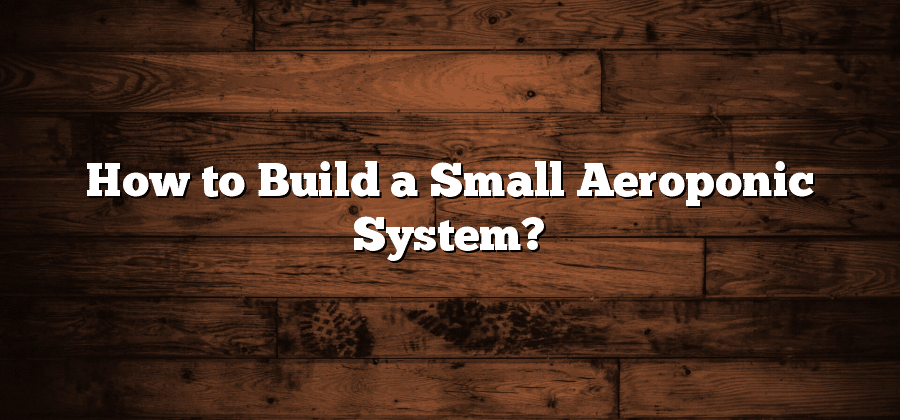Components of a Small Aeroponic System
To ensure the successful growth of plants in an aeroponic system, several components must be carefully selected and integrated. The heart of a small aeroponic system is the reservoir, which holds the nutrient solution that is responsible for nourishing the plants. It is essential to choose a reservoir that is durable, non-toxic, and able to hold a sufficient amount of nutrient solution for the plants’ needs. Additionally, a high-quality pump is required to provide a constant flow of nutrient solution to the plant roots. The pump should be reliable, energy-efficient, and capable of delivering the solution at a consistent pressure.
In addition to the reservoir and pump, another crucial component of a small aeroponic system is the misting system. This system disperses the nutrient solution as a fine mist, allowing the plant roots to absorb the necessary nutrients and oxygen. The misting system should be designed for efficiency, ensuring an even distribution of mist across all the plant roots. Properly placed misting nozzles or sprayers, along with adjustable timers, are necessary to achieve optimal moisture levels for plant growth. By carefully selecting these components, one can create a small aeroponic system that provides the necessary elements for successful plant cultivation.
Designing an Efficient Aeroponic System
When designing an efficient aeroponic system, there are several key factors to consider. One of the most important is the placement and arrangement of the misting nozzles. These nozzles are responsible for delivering the nutrient solution to the plant roots, so it’s crucial to ensure even distribution. Placing the nozzles too close together can lead to oversaturation in some areas, while spacing them too far apart can result in inadequate moisture for the plants. Striking the right balance is key to optimizing growth and minimizing waste.
Another aspect to consider when designing an efficient aeroponic system is the size and capacity of the reservoir. The reservoir is where the nutrient solution is stored before being misted onto the plant roots. It’s important to choose a reservoir size that can adequately supply the entire system without the need for constant refilling. Additionally, ensuring proper circulation and agitation within the reservoir can prevent nutrient buildup and promote oxygenation of the solution. These factors can contribute to the overall efficiency and effectiveness of the aeroponic system.
Selecting the Right Container for Aeroponics
When it comes to aeroponics, selecting the right container is crucial for the success of your system. The container serves as the home for your plants’ roots, providing them with support, protection, and space to grow. One of the key factors to consider when choosing the right container is its size. You want to ensure that the container is large enough to accommodate the root system of your plants, allowing them to spread and develop without being constrained. At the same time, the container should not be too large, as this can lead to excessive use of nutrient solution and energy. Finding the balance between size and efficiency is essential.
Another important aspect to consider when selecting a container for aeroponics is its material. The container should be made of a durable and non-toxic material that is resistant to environmental conditions. This is particularly important as aeroponic systems typically have a high humidity level, and certain materials may degrade or release harmful substances when exposed to these conditions. Additionally, the container should be able to withstand the weight of the growing medium, the plants, and the nutrient solution. Plastic containers are a popular choice due to their affordability, durability, and resistance to corrosion. However, it is important to ensure that the plastic used is food-grade and does not contain any harmful chemicals that could potentially leach into the nutrient solution and affect the growth of your plants.
Choosing the Ideal Growing Medium
The growing medium plays a vital role in the success of an aeroponic system. It serves as the anchor for the plant roots and provides a home for beneficial microorganisms. When choosing the ideal growing medium for your aeroponic setup, there are a few factors to consider.
Firstly, you want a medium that promotes good water retention while allowing proper oxygenation. This is crucial for the roots to thrive and absorb nutrients efficiently. Additionally, it should have a balanced pH level and be free from contaminants. To achieve these criteria, some commonly used growing mediums for aeroponics include rockwool, perlite, coconut coir, and clay pebbles. Each medium has its own advantages and disadvantages, so it’s important to understand their specific characteristics and how they relate to your specific needs.
Understanding the Importance of Nutrient Solution
The nutrient solution is a vital component of any aeroponic system as it provides the necessary nutrients for plant growth and development. These nutrients are typically dissolved in water and delivered directly to the roots, ensuring that plants have easy access to the essential elements they need.
The nutrient solution must be carefully formulated to meet the specific requirements of the plants being grown. This involves considering factors such as the plant species, growth stage, and desired yield. The solution should contain a balanced combination of macronutrients (such as nitrogen, phosphorus, and potassium) and micronutrients (such as iron, zinc, and manganese). It is crucial to monitor and adjust the nutrient levels regularly to maintain optimal plant health and prevent deficiencies or toxicities. Additionally, the pH of the nutrient solution must be carefully managed to ensure proper nutrient uptake by the plants.






